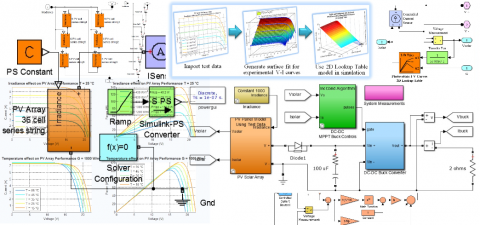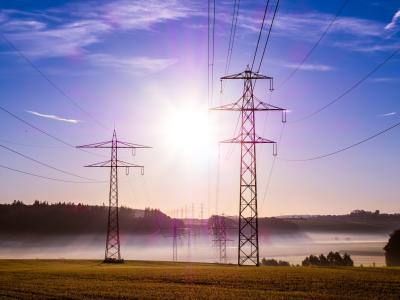Datasets
Open Access
Modeling and Simulation of Photovoltaic Arrays in Matlab and Simulink
- Citation Author(s):
- Submitted by:
- Ioan Banu
- Last updated:
- Fri, 11/22/2024 - 10:23
- DOI:
- 10.21227/H2463S
- Data Format:
- Links:
- License:
- Creative Commons Attribution
 12634 Views
12634 Views- Categories:
- Keywords:
Abstract
The dataset contains fundamental approaches regarding modeling individual photovoltaic (PV) solar cells, panels and combines into array and how to use experimental test data as typical curves to generate a mathematical model for a PV solar panel or array.
Modeling and Simulation of Photovoltaic Arrays
This work presents a method of modeling and simulation of PV solar arrays in Matlab and Simulink and modeling of PV solar arrays using experimental test data to create a PV array simulator. To build the PV panel was used the Solar Cell block from SimElectronics advanced component library and to implement the fixed predictive model that can be used as a source for a PV system was used Curve Fitting Tools.
The method is used to determine the characteristic of a particular PV cell panel and to study the influence of different values of solar radiation at different temperatures concerning performance of PV cells.
This model can be used to build a PV circuit model for any PV array. All modules which form the PV system model are individually modeled and validated in Simulink. The built model was validated through simulation. The simulation results show that the proposed method is efficient in terms of modeling of the functioning of PV systems.
Study on Temperature for Modeling of Photovoltaic Solar Array using Experimental Test Data
The work presents a study on temperature in case of modeling of PV solar arrays using experimental test data (PV simulator) in Matlab/Simulink program. Starting from the mathematical model is realized the PV source model for different temperatures using a custom equation model or cubic interpolation in Curve Fitting Tool and finally are presented some generated fit results of the three-dimensional current–voltage (I–V) surface of PV array.
This work is useful in modeling of PV solar arrays. The proposed study use Curve Fitting Toolbox to create a stable fit because the I–V behavior is static, but for dynamic systems are used experimental data, and for this case is used a predictive models for PV solar array.
Study regarding modeling photovoltaic arrays using test data in Matlab/Simulink
The work presents a study on two ways of modeling PV solar arrays in Matlab/Simulink environment. The main objective consists to compare different ways of modeling PV solar arrays in Matlab/Simulink that are the 5-parameters model of PV array using experimental test data and the 5-parameters model of PV array using fundamental approaches of first principles Simulink.
In this study it is not follow the three-dimensional surface of I–V characteristic curves of PV solar array but the power obtained at the output of a PV system formed by a PV solar array and respectively using first principles Simulink, a step-down (buck) dc-dc converter, and a Maximum Power Point Tracking (MPPT) controller with incremental conductance algorithm. The simulation results show that, using the proposed model for the source of a PV solar array, the output power of PV panel is higher and have slight variations that imply the choice of PV solar array model as being as close as possible to reality.
The two PV Array sources relied on models for the PV Solar Array Simulator with step-down dc-dc converter and MPPT control. Given that the PV Solar Array Simulator was simulated for different PV Array sources, and having as the argument the power obtained at the output of PV Panel is decide the superiority of PV Array model using experimental data over the PV Array model using first principles Simulink.
This work is useful in modeling PV energy production systems. A possible applicability of this obtained results is the achievement of a PV Simulator, that are used to study its operation in different conditions (irradiance, temperature, load profiles).
Please cite my papers in your work:
I. V. Banu and M. Istrate, "Modeling and simulation of photovoltaic arrays," Buletinul AGIR, World Energy Systems. Towards Sustainable and Integrated Energy Systems (Paper presented at the 9th International World Energy System Conference WESC 2012, June 28-30, 2012, Suceava), no. 3, pp. 161-166, 2012. ISSN-L: 1224-7928, ISSN: 2247-3548
URL: http://www.buletinulagir.agir.ro/articol.php?id=1378
I. V. Banu, M. Istrate, D. Machidon, and R. Pantelimon, "Study regarding modeling photovoltaic arrays using test data in MATLAB/Simulink," Scientific Bulletin, Series C Electrical Engineering and Computer Science (International Conference on Energy and Environment - CIEM 2013, 7-8 November 2013, University Politehnica of Bucharest, Politehnica Press, pp. 7-12, ISSN: 2067-0893), vol. 2, no. 77, pp. 227-234, 2015, University Politehnica of Bucharest. ISSN: 2286-3540
URL: https://www.scientificbulletin.upb.ro/rev_docs_arhiva/full83f_148621.pdf
I. V. Banu, R Beniuga, and M. Istrate, "Study on Temperature for Modeling of Photovoltaic Solar Array using Experimental Test Data," Acta Electrotehnica (Special Issue Proceedings of the 5th International Conference on Modern Power Systems MPS 2013, 28-31 May 2013, Cluj-Napoca), vol. 54, no. 5, pp. 51-54, Ed. Mediamira, 2013. ISSN: 1841-3323
URL: http://www.et.utcluj.ro/mps/
This dataset contain a PV Arrays Models Pack with some models of PV Solar Arrays carried out in Matlab and Simulink. The PV Models are grouped in three ZIP files which correspond to the papers listed above.
Dataset Files
PV Arrays Model 1. Banu - WESC 2012-PV Arrays Model (Matlab-Simulink R2011b).zip (426.57 kB)
Data Extraction PV Model 2. Banu - MPS 2013-Data Extraction PV Model (Matlab-Simulink R2012a).zip (943.24 kB)
PV Solar Array Simulator 3. Banu - CIEM 2013-PV Model (Matlab-Simulink R2012b).zip (8.91 MB)
Open Access dataset files are accessible to all logged in users. Don't have a login? Create a free IEEE account. IEEE Membership is not required.











Comments
Thank you! is really helpful.
You're welcome!
thanks! good work!
I truly appreciate that. Thank you so much.